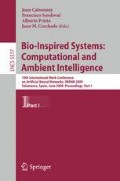Abstract
Cluster analysis is a technique used in a variety of fields. There are currently various algorithms used for grouping elements that are based on different methods including partitional, hierarchical, density studies, probabilistic, etc. This article will present the SODTNN, which can perform clustering by integrating hierarchical and density-based methods. The network incorporates the behavior of self-organizing maps and does not specify the number of existing clusters in order to create the various groups.
Access this chapter
Tax calculation will be finalised at checkout
Purchases are for personal use only
Preview
Unable to display preview. Download preview PDF.
References
Furao, S., Ogura, T., Hasegawa, O.: An enhanced self-organizing incremental neural network for online unsupervised learning. Neural Networks 20, 893–903 (2007)
Kohonen, T.: Self-organized formation of topologically correct feature maps. Biological Cybernetics, 59–69 (1982)
Fritzke, B.: A growing neural gas network learns topologies. In: Tesauro, G., Touretzky, D.S., Leen, T.K. (eds.) Advances in Neural Information Processing Systems, vol. 7, pp. 625–632 (1995)
Martinetz, T., Schulten, K.: A neural-gas network learns topologies. Artificial Neural Networks 1, 397–402 (1991)
Carpenter, G.A., Grossberg, S.: The ART of adaptive pattern recognition by a self-organizing neural network. IEEE Trans. Computer, 77–88 (1987)
Shen, F.: An algorithm for incremental unsupervised learning and topology representation. Ph.D. thesis. Tokyo Institute of Technology (2006)
Saitou, N., Nie, M.: The neighbor-joining method: A new method for reconstructing phylogenetic trees. Mol. Biol. 4, 406–425 (1987)
Xu, L.: Bayesian Ying–Yang machine, clustering and number of clusters. Pattern Recognition Letters 18(11-13), 1167–1178 (1997)
Kaufman, L., Rousseeuw, P.J.: Finding Groups in Data: An Introduction to Cluster Analysis. Wiley, New York (1990)
Corchado, J.M., De Paz, J.F., Rodríguez, S., Bajo, J.: Model of experts for decision support in the diagnosis of leukemia patients. Artificial Intelligence in Medicine (in Press)
Hartigan, J.A., Wong, M.A.: A K-means clustering algorithm. Applied Statistics 28, 100–108 (1979)
Campos, R., Ricardo, M.: A fast algorithm for computing minimum routing cost spanning trees 52(17), 3229–3247 (2008)
Bajo, J., De Paz, J.F., De Paz, Y., Corchado, J.M.: Integrating case-based planning and RPTW neural networks to construct an intelligent environment for health care. Expert Systems with Applications 36(3) (2009)
UC Irvine Machine Learning Repository, http://archive.ics.uci.edu/
Patricio, M.A., Carbó, J., Pérez, O., García, J., Molina, J.M.: Multi-Agent Framework in Visual Sensor Networks. EURASIP Journal on Advances in Signal Processing, special issue on Visual Sensor Networks, 21 (2007)
Carbó, J., Molina, J.M., Dávila, J.: Fuzzy Referral based Cooperation in Social Networks of Agents. AI Communications 18(1), 1–13 (2005)
García, J., Berlanga, A., Molina, J.M., Casar, J.R.: Methods for Operations Planning in Airport Decision Support Systems. Applied Intelligence 22(3), 183–206 (2005)
Pavón, J., Arroyo, M., Hassan, S., Sansores, C.: Agent-based modelling and simulation for the analysis of social patterns. Pattern Recognition Letters 29, 1039–1048 (2008)
Pavón, J., Gómez, J., Fernández, A., Valencia, J.: Development of intelligent multi-sensor surveillance systems with agents. Robotics and Autonomous Systems 55(12), 892–903 (2007)
Author information
Authors and Affiliations
Editor information
Editors and Affiliations
Rights and permissions
Copyright information
© 2009 Springer-Verlag Berlin Heidelberg
About this paper
Cite this paper
De Paz, J.F., Rodríguez, S., Bajo, J., Corchado, J.M., López, V. (2009). Self Organized Dynamic Tree Neural Network. In: Cabestany, J., Sandoval, F., Prieto, A., Corchado, J.M. (eds) Bio-Inspired Systems: Computational and Ambient Intelligence. IWANN 2009. Lecture Notes in Computer Science, vol 5517. Springer, Berlin, Heidelberg. https://doi.org/10.1007/978-3-642-02478-8_28
Download citation
DOI: https://doi.org/10.1007/978-3-642-02478-8_28
Publisher Name: Springer, Berlin, Heidelberg
Print ISBN: 978-3-642-02477-1
Online ISBN: 978-3-642-02478-8
eBook Packages: Computer ScienceComputer Science (R0)

